Saol & Saothar Charlotte Brooke
Published in 18th–19th - Century History, Features, Issue 2 (Summer 2001), Volume 9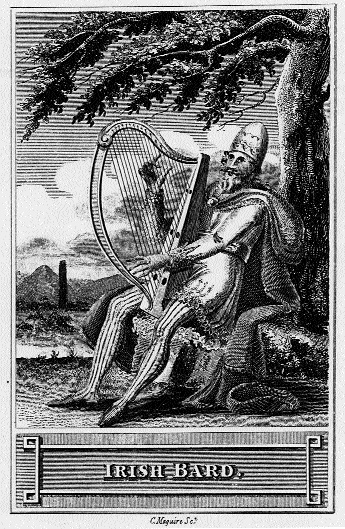
Illustration from Historical Memoirs of the Irish Bards by Joseph Walker.
Cé hí Charlotte Brooke? Bhí an-chlú uirthi agus í beo, agus fiú céad bliain ina dhiaidh sin. Ach tá dearmad déanta uirthi anois taobh amuigh de na hollscoileanna. Bhí páirt an-tábhachtach ag Charlotte i gcéad athbheochan na Gaeilge, mar d’fhoilsigh sí leabhar dar teideal Reliques of Irish Poetry i 1789. Bailiúchán dánta as Gaeilge atá ann, agus na haistriúcháin fhileata a rinne sí féin.
Fuair sí bás i 1793, agus bliain ina dhiaidh thug an iris mhór le rá Anthologia Hibernica ‘this truly amiable and ingenious young lady’ uirthi, agus dúirt: ‘Charlotte…was one of the brightest literary ornaments of this country’. Bhí Charlotte an-tógtha le filíocht agus amhránaíocht na Gaeilge. Agus é seo i dtráth a raibh an teanga faoi chois, agus drochmheas á chaitheamh go forleathan uirthi. Scríobh sí:
It is really astonishing of what various and comprehensive powers this neglected language is possessed…It is scarcely possible that any language can be more adapted to lyric poetry than the Irish. The poetry of many of our songs is indeed already music, without the aid of a tune.
Faoi cheol na hÉireann scríobh sí, ‘there is no other music in the world so calculated to make its way directly to the heart: it is the voice of Nature, and Sentiment, and every fibre of the feeling breast is in unison with it’.
Ag an am, bhí na Caitlicigh ina dtromlach mór agus iad gan talamh, gan saibhreas, gan chumhacht. Meastar go raibh 4.75 milliún duine in Éirinn. Ó thaobh 2.5 milliún acu, meastar gur Gaeilge amháin a bhí acu, nó gurbh fhearr leo Gaeilge a labhairt. Bhí an chuid is mó acusan san iarthar, ach bhí ‘pócaí’ san oirthear freisin, go háirithe in áiteanna ina raibh talamh bocht. Bhí an coincheap ‘náisiúnachas Protastúnach’ san aer i measc na mionuaisle Protastúnacha. Ba mhaith leo a saol cultúrtha féin freisin. Bunaíodh Acadamh Ríoga na hÉireann i 1785, múnlaithe ar dheilbh an Acadaimh Ríoga i Sasana. An bhallraíocht, ba dhaoine uaisle iad agus intleachtaigh, chóir a bheith uilig ina bProtastúnaigh, agus fir uilig.
Bhí an rómánsaíocht faiseanta, a bhain leis an stíl Ghotach. Cuireadh béim ar mhothúcháin, ar lucht na tuaithe idéalaithe, agus ar sheanlitríocht na tíre féin, chan ón Ghréig nó ón Róimh. In Albain d’fhoilsigh James MacPherson scéalta Ossian i 1760—fuair sé seanscéalta Éireannacha agus lig sé air gur scéalta Albanacha iad. D’fhoilsigh Thomas Percy Reliques of Ancient English Poetry i 1765. Níos moille, rinneadh easpag ar Dhroim Mór i gContae an Dúin de Phercy: bhí Charlotte Brooke i dteagmháil leis, agus fuair sí a teideal ón leabhar s’aige.
Muintir Charlotte
Ba de na mionuaisle Protastúnacha í Charlotte. Deirtear gur tháinig a sinsir ar an dá thaobh go hÉirinn sa seachtú haois déag. Seanathair Charlotte, William Brooke, ba mhinistir i gContae an Chabháin é. Phós seisean Lettice Digby, iníon easpag Ail Finn. Chónaigh siad i dteach darbh ainm Rantavan, in aice leis an Mhullach idir Achadh an Iúir agus Ceanannas Mór. Anseo a rugadh athair Charlotte, Henry Brooke, meastar i 1703, agus Charlotte féin. Agus Henry sna fichidí, phós sé Catherine Meares, a bhí muinteartha do. Bhí sise thart fá cheithre bliana déag d’aois, agus phós siad dhá uair — faoi cheilt, ansin arís go hoscailte. Bhí beirt pháiste is fiche acu, ach níor mhair ach an bheirt dheireanach —Charlotte agus Arthur—go dtí bliain is fiche d’aois.
Bhí Henry agus a bhean an-mhór le chéile. Bhí Catherine láidir agus, is dócha. níos ciallmhaire ná eisean. Bhí Henry ina bhall d’Eaglais na hÉireann, ach bhí Catherine ina Modhach, agus lean Charlotte í. Ba scríbhneoir clúiteach é Henry Brooke. Scríobh sé a lán drámaí agus paimfléad. Fuair sé oideachas mar dhlíodóir, ach chuaigh sé le saol litríochta. Chónaigh sé i Londain ar feadh tréimhsí éagsúla. D’éirigh leis, go háirithe i ndiaidh gur chuir Tiarna an tSeomra cosc ar dhráma a scríobh sé, dar teideal Gustavus Vasa.
Duine beag le súile móra lán de bhrí a bhí ann, agus mothúcháin mhíne aige. Agus Henry ina pháiste scoile, de réir cuntais:
A young man…addressed some verses to him in the Irish language. He was so highly pleased with this little nosegay of native flowers, that he resolved to learn the Irish language, a resolve, with many others, which he never put into execution.
Scéim eile a thosaigh sé gan a chríochnú, ba é sin stair na hÉireann a scríobh.
Cé go raibh Henry báúil le cultúr agus cosmhuintir na tíre, bhí eagla air roimh dhearcadh polaitiúil na ndaoine, agus bhí sé san amhras faoin Phápacht — cé nach raibh sé buartha faoin Chaitliceachas mar chreideamh pearsanta. Bhí conspóid ann faoi phaimfléad a scríobh sé i 1745, i ndiaidh éirí amach na Seacaibíteach in Albain, inar mhol sé do na Protastúnaigh bheith réidh le hionradh. Níos moille, áfach, d’fhoilsigh sé paimfléad a mhol cearta do Chaitlicigh. Ba í Charlotte an t-aonú pháiste is fiche. Thug Henry ‘the child of his old age’ uirthi, agus bhí an-ghrá eatarthu. Thit Catherine i dtinneas agus Charlotte ina déagóir, nó roimhe sin, agus thug Charlotte aire di. Bhí Catherine croíbhriste nuair a fuair ‘a very dear daughter’ bás (an seachtú páiste a fuair bás), agus fuair sí féin bás gan mhoill, sna 1770í. Níl bliain bhreithe Charlotte againn. Tá réimse mór meastachán ann, ó 1740 go dtí 1760. Seans maith gur idir 1755 agus 1760 a rugadh í. I ndiaidh gur rugadh Charlotte, tháinig deacrachtaí airgeadais ar Henry, agus bhí air an teach sin, Rantavan, a dhíol. Chaith an teaghlach cúpla bliain i gContae Chill Dara in aice leis An Nás. Ansin d’fhill siad go Contae an Chabháin. Thóg Henry teach ag Corfad, cóngarach don tseanáit.
Thug Henry oideachas ar dóigh do Charlotte. Scríobh beathaisnéisí s’aici, Aaron Crossley Seymour, faoina phlean oideachais:
In this plan he proposed to reject the severity of discipline; and to lead her mind insensibly to knowledge and exertion, by exciting her curiosity, and directing it to useful objects. By this method, Miss Brooke’s desire to learn became as eager as her parent’s wish to teach; and…in her fifth year she was able to read, distinctly and rapidly, any English book.
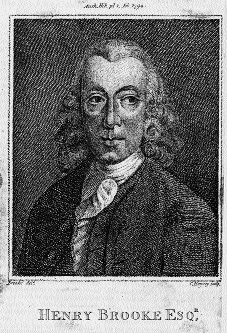
D’fhoghlaim sí Iodáilis, Fraincis, líníocht agus ceol, agus bhí gairdín beag aici freisin. Ar feadh tréimhse, bhí sí an-tógtha leis an amharclann. Scríobh sí dráma, tragóid dar teideal Belisarius, ach tá an téacs caillte.
Áit Ghaelach
Bhí an ceantar thart ar An Mhullach chóir a bheith lán-Ghaeilge in am Charlotte. Cuid de sheancheantar Gaeilge darbh ainm Oirialla a bhí ann, ina raibh traidisiún láidir ó thaobh litríocht na Gaeilge de.
Scríobh cuairteoir go raibh cuma neamhthorthúil fhiáin ar an áit. Is cosúil nach raibh mórán Protastúnach thart, agus gur chaith Charlotte tamall maith le muintir na háite agus í ina páiste óg. Fuair sí a suim sa Ghaeilge uathu. Scríobh cara mór dá cuid, Joseph Walker, fúithi:
A young lady…informed me, that her father had a labourer, who was in possession of two volumes of Irish manuscript poems, which, in her infancy, she often heard him read to a rustic audience in her father’s fields. The bold imagery, and marvellous air, of these poems, so captivated her youthful fancy, that they remained for some years strongly impressed on her memory. When Mr. MacPherson’s Ossian’s Poems were put into her hands, she was surprised to find in them her favourite Irish tales, decked with meretricious ornaments.
Thosaigh Charlotte a bhailiú amhrán agus filíocht na Gaeilge nuair a bhí sí óg. Deirtear gur tháinig muintir na háite chuici ‘with all the scattered verses that memory could collect’. Scríobhadh a lán dánta di freisin, agus scríobh Charlotte a dánta féin. Ansin rinne sí stáidéar ar an Ghaeilge. Dúirt Seymour:
Miss Brooke’s passion for literature and general information daily increased, and frequently after the family had retired to rest, she would leave her bed, dress herself, and steal down to the study to read. To these nocturnal exercises of her mind she attributed her greatest advances in knowledge… The study of antiquities…was that for which she conceived a passionate curiosity. It led her insensibly into the study of the Irish language, to which she adhered so closely and so successfully, that with little or no assistance, she, in less than two years, became perfect mistress of it.
Rinne cuairteoir ar Chorfad sna 1770í cur síos ar theaghlach Brooke. Fear beag ab é Henry, le fallaing fhada bhuí agus bréagfholt go dtí a chuid guaillí. Dúirt an cuairteoir: ‘I never saw so affectionate a husband and so tender a father in my life.’ Bhí a bhean ‘quite emaciated and so feeble that she can scarce walk across the room’. Agus faoi Charlotte: ‘the daughter inherits a considerable portion of the countenance of the father but she is as pale as a primrose and almost as thin as her mother’.
Ag an dinnéar, bhí comhrá acu faoi mhuintir na háite:
You would really think that Mr Brooke was talking of his own children they were all so dear to him; he prayed for them and blessed them over and over again with tears in his eyes. Miss Brooke dwelt on their talents; ready turns of wit; their passion for poetry, music, and dancing.
Bhí súil ag an chuairteoir go dtaispeánfadh Charlotte cuid dá filíocht féin dó, ach níor thaispeáin. Scríobh sé: ‘I am told by a lady of refined taste, who is very intimate with her, that she has written some verses that breathe, if I may use the expression, Promethean fire.’
Méid mór deacrachtaí
Sna 1770í, thit saol Charlotte as a chéile. Fuair deirfiúr dá cuid bás, ansin a mamaí. Dá bhrí sin—agus ní raibh sláinte mhaith aige in aon chor—chuaigh Henry as a mheabhair, agus fuair sé bás i 1783. Ansin fuair deartháir Charlotte, Arthur, bás san India, mar chaptaen san East India Company.
Ní raibh sláinte mhaith ag Charlotte ach oiread. Agus ansin tháinig méid mór deacrachtaí uirthi. Nuair a fuair Henry bás, bhí go leor airgid aici. Ach chuir sí ar fuilleamh an chuid is mó de i ngnó de chuid a col ceathrair, an Captaen Robert Brooke. D’éirigh seisean saibhir nuair a bhí sé i mbun saighdiúireachta san India, ansin thóg sé sráidbhaile tionsclaíoch sa Chorrchoill (Prosperous), Contae Chill Dara, ina raibh 1,400 seol cadáis. Chuir Charlotte an chuid eile dá hairgead ar fuilleamh le trádálaí. Theip ar an dá ghnó thart fá 1787, agus chaill Charlotte gach aon rud.
Bhí uirthi a teach ag Corfad a dhíol. Ansin chónaigh sí le cairde i mBaile Átha Cliath agus in áit darbh ainm Cottage, in aice leis An Longfort. B’éigean di foinsí airgid a aimsiú go práinneach. I measc a cuid cairde, bhí fear óg díograiseach Protastúnach darb ainm Joseph Walker, a chónaigh i mBré. I 1786 d’fhoilsigh sé bailiúchán mór eolais, Historical Memoirs of the Irish Bards. Bhí trí amhrán ann aistrithe ag ‘a young lady whose name I am enjoined to conceal’. Ba í sin Charlotte.
Agus Charlotte san fhaopach, mhol Joseph Walker agus cairde eile di iarratas a dhéanamh fá choinne post mar bhean tí ag Acadamh Ríoga na hÉireann. Scríobh sí chucu: ‘My Lords and Gentlemen…I address you as the daughter of Gustavus Vasa—a man, who either as a friend, or a patriot, was dear to every member of your Academy’.
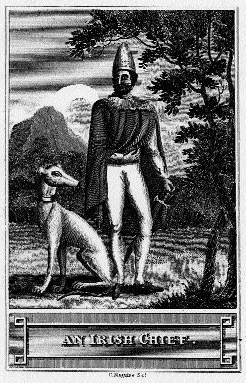
Illustration from Historical Memoirs of the Irish Bards by Joseph Walker.
Dúirt sí go raibh sí ‘stripped of both friends and fortune’, agus d’iarr sí ‘to be intrusted with the care of a house destined to the purpose, and dedicated to the honour of genius’. Dúirt sí go n-oibreodh sí gan tuarastal, dá mba riachtanach.
Scríobh sí chuig an Easpag Percy ag iarraidh a thacaíochta, agus labhair sé amach ar a son ag cruinniú an Acadaimh. Ach bhí raic ann fá dtaobh dá hiarratas, agus sa deireadh tharraing sí siar é, nuair a fuair sí amach go raibh uachtarán an Acadaimh, Lord Charlemont, ina héadan. Mar chuid den chonspóid, mar a scríobh sí féin:
Dr Stack…urged me to accept of the place of tutoress in a nobleman’s family of this kingdom, hoping I suppose, by that proposal, at once to humble and get me out of the way. To the hand of heaven I am ready to submit, but Mr Stack presumes to anticipate its decrees.
Bliain níos moille, scríobh sí chuig an easpag arís faoi thionscadal nua, a mhol dhá ‘gentlemen’, Judge Hellen agus Dominick Trant, di:
They have almost persuaded me into a belief that it may be in my power to rescue from oblivion at least some portion of the native beauties of the language and genius of this neglected country: they wish me to translate into English verse some of our fine Irish manuscripts, which, for want of such translation, are unknown to the world, and they will kindly take upon themselves the care of the publication, which, they say, shall be by subscription.
I have already advanced pretty far in my work. I have translated several manuscripts which appeared to me to be possessed of considerable poetical merit, and I have the pleasure of seeing the first timid efforts of my pen approved of.
Ansin d’iarr sí air lámhscríbhinní a sheoladh chuici, mar ‘I find it very difficult to procure any manuscripts that are worthy of translation, and my stock is now nearly out’.
Fuair Charlotte lámhscríbhinní ó Sylvester O’Halloran, máinlia mór le rá; agus ó na scoláirí Theophilus Ó Flannagáin agus Muiris Ó Gormáin. Scaip Joseph Walker agus cairde eile an scéal faoin obair s’aici, agus fuair siad a lán foscríobhaithe mór le rá le costais cló a íoc.
Seoladh Reliques
Foilsíodh leabhar Charlotte i 1789 faoin teideal Reliques of Irish Poetry. Is leabhar mór é, agus sé dhán déag ann—a haistriúcháin fhileata féin, agus na buntéacsanna Gaeilge ag an deireadh. Tá roinnt mhaith acu measartha fada. Tá ceithre sórt dáin ann, agus réamhrá le gach rannóg: ‘heroic poems’, ‘odes’, ‘elegies’, agus amhráin. Tá fonótaí lán d’eolas ann freisin. Ag an deireadh, tá dán fada dá cuid féin ann, ar théama miotaseolaíoch.
Sa réamhrá dhearbhaigh sí:
The productions of our Irish Bards exhibit a glow of cultivated genius, a spirit of elevated heroism, sentiments of pure honor, instances of disinterested patriotism, and manners of a degree of refinement, totally astonishing, at a period when the rest of Europe was nearly sunk in barbarism: And is not all this very honorable to our countrymen? Will they not be benefited, will they not be gratified, at the lustre reflected on them by ancestors so very different from what modern prejudice has been studious to represent them?
B’an-eol do Charlotte na deacrachtaí a bhaineann le haistriúcháin. D’admhaigh sí gur thit sí in éadóchas in aghaidh ‘many a sweet stanza to which I found myself quite unequal.’ Tugann sí an véarsa seo mar shampla:
A cheann dubh dílis dílis dílis!
Cuir do cheann dílis tharam anall!
A bhéilín meala, a bhfuil boladh na thyme air,
Is duine gan chroí nach dtiúbhradh dhuit grá!
Dúirt sí féin go raibh sí ag éirí spiorad na ndánta a chur in iúl. Sa dóigh sin, tá sí cosúil lena lán filí a tháinig ina diaidh. Cosúil leosan, freisin, tá a cuid aistriúchán sáite sa dearcadh agus stíl a bhí ann ag an am. Tá siad ró-rómánsúil agus ró-ornáideach dúinne. Tá siad níos faide ná an Ghaeilge freisin, agus níl siad chomh nithiúil. Ach thaitin siad go mór le lucht a comhaimsire. Seo sampla dá filíocht—an bunrud agus an leagan a rinne Charlotte:
Sí mo chuisle sí mo rún í
agus blath na n-úll cumhra í.
Seo aistriúchan litriúil:
She is my pulse and my love
and the flower of the sweet-scented apple.
Seo leagan Charlotte:
Pulse of my heart!—dear source of care,
Stol’n sighs, and love-breath’d vows!
Sweeter than when, through scented air,
Gay bloom the apple boughs!
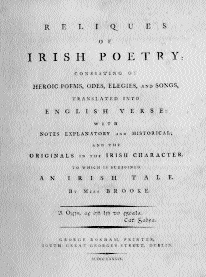
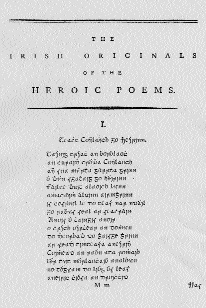
Page from Reliques of Irish Poetry
An dúil ba mhó aici, amhránaíocht na ndaoine. Sa dóigh sin, bhí a hintinn féin aici, mar níor tugadh mórán airde ar dhánta mar sin ag an am. Céad bliain níos moille, lean Dubhghlas de hÍde a lorg. Ach an chuid is mó de na dánta, is as na lámhscríbhinní iad, laoithe agus a leithéid. Don lucht léitheoireachta nua-aimseartha, seans go bhfuil guth Charlotte níos fóirsteanaí don sórt sin dáin.
The School for Christians
Nuair a thit an tóin as domhan Charlotte, thiontaigh sí go tréan ar a creideamh. ‘Every human prop was plucked from under me, and I was thrown, of necessity, upon God’, a scríobh sí chuig a col ceathrair, coicís sula bhfuair sí bás. I 1791 d’fhoilsigh sí leabhar beag dar teideal The School for Christians, in Dialogues, for the Use of Children. Bhí dearcadh mín aici—bhí a beathaisnéisí, Seymour, ina Mhodhach freisin, ach bhí seisean i bhfad níos déine.
Feictear tionchar a hathar sa School for Christians, agus an dúil a bhí ag Charlotte sna páistí:
Filiolus: Good morrow, papa.
Patern: Good morrow, my love. What is the matter? Your eyes look red.
Filio: Oh, papa! that story you were telling me, out of the Bible, last night, made me so melancholy! I could not help crying to think what a pity it was of Adam and Eve, to grow so naughty, after God had made them so good!
Scéim eile a bhí idir lámha aici, ba é sin saothar a hathar a chur i gcló mar ba cheart. Bhí jab míshásúil déanta ag duine thall i Sasana, nuair a bhí a hathair ró-lag san intinn le bheith ábalta súil a choinneáil air. Rinne sí ath-eagarthóireacht ar shaothar a hathar, agus scríobh sí beathaisnéis bheag faoi. Tháinig sé amach i 1792.
Bhí a lán streachailte le clódóirí agus díoltóirí leabhar i gceist. Luaigh sí: ‘Difficulties in the transaction of business with booksellers of another kingdom, whose negligence was rendered still more supine, by knowing that they had only female resentment to fear.’ Scríobh sí chuig a cara Miss T:
McKenzie (the College printer) who unfortunately printed my father’s works, has harassed me by every species of impudence, insolence, and *******. Until a week ago I was not able to get the last of the books out of his hands, and I then found there were a number of copies wanting. I refused to pay his bill, till he gave them all up, and he threatened me with a suit. Any court in Christendom would have given it against him, and he was told so; but he knew I disliked contention, and therefore bullied me to obtain what he had no right to.
I ndiaidh gur foilsíodh Reliques, bhí go leor airgid aici. D’inis sí don Easpag Percy go dtabharfadh sí brabús ó The School for Christians do charthanas. Fá choinne a cuid riachtanas féin, cheannaigh sí teacht isteach bliantúil agus luach £40 sa bhliain air. Ach bhí sé ró-mhall.
Bhí sí tinn lag. I mí an Mhárta 1793 chuaigh sí ó Bhaile Átha Cliath go teach a cairde in aice leis An Longfort. Thaistil sí in éadan chomhairle an dochtúra. Fuair sí fiabhras, agus fuair sí bás ar 29 Márta. Seans nach raibh sí ach thart fá chúig bliana is triocha d’aois. Athchlódh roinnt dá haistriúcháin fhileata in Bolg an tSolair, iris Ghaeilge a d’fhoilsigh Tomás Ruiséil agus Pádraig Ó Loinsigh i mBéal Feirste i 1795. Athfhoilsíodh Reliques in 1816 agus 1825. Nuair a tháinig athbheochan nua ar an saol céad bliain níos moille, bhí Reliques mar bhunfhoinse ag Dubhghlas de hÍde agus Lady Gregory. Ba cheart dúinne cuimhneamh ar Charlotte freisin.
The Life & Work of Charlotte Brooke
by Liz Curtis
Charlotte Brooke’s book Reliques of Irish Poetry was published in 1789 during the first cultural revival, winning her instant fame. It contained her own poetic translations of sixteen Irish poems, together with the originals and extensive background information. Charlotte was immensely enthusiastic about Irish-language poetry and song at a time when Irish was despised as the language of the poor, though still spoken by the majority.
Charlotte’s family
Her ancestors on both sides are said to have come to Ireland in the seventeenth century. Her parents were Henry Brooke and Catherine Meares, and Charlotte was the twenty-first of twenty-two children, only two of whom reached the age of twenty-one. Her date of birth is unknown, but was probably between 1755 and 1760. Her father, Henry, was a famous though impecunious dramatist and pamphleteer, who was very interested in Irish history and expressed an interest in learning the language, though he never did. He had progressive educational ideas, encouraging his daughter’s curiosity in a wide range of subjects, so that by the age of five she was able to read ‘distinctly and rapidly’.
Gaelic district
Charlotte gained her love for the language as a child from people in her home area, a then-remote and wild part of County Cavan between Virginia and Kells. This was part of the ancient Gaelic district of Oirialla, which had a strong literary tradition. One of her father’s labourers had two volumes of Irish manuscript poems, which he often read aloud ‘to a rustic audience’, and which entranced the listening child. Later she used to study in the middle of the night, and in less than two years became ‘perfect mistress’ of Irish.
An abundance of problems
Her world began to fall apart in the 1770s. A sister died—the seventeenth child to die—and her heartbroken mother—an invalid, cared for by Charlotte—soon followed. These tragedies drove Henry out of his mind, and he died in 1783. Then her brother died in India, leaving her alone. Money difficulties followed, as companies she invested in—one an industrial village belonging to a cousin—failed.
Three of Charlotte’s translations of Irish poems were published anonymously by her great friend Joseph Walker in his book, Historical Memoirs of the Irish Bards. He advised her to apply for a post of housekeeper at the Royal Irish Academy—no women were then members. Her application provoked arguments—one member advised her to get a job as a tutoress—and she withdrew it.
Publication of Reliques
Friends then suggested that she translate into verse ‘some of our fine Irish manuscripts’, and they would organise the publication. The result was Reliques of Irish Poetry, published in 1789. With this work Charlotte blazed a trail which was followed a century later by Douglas Hyde.
The School for Christians
When problems engulfed her, Charlotte—a Methodist like her mother—found solace in religion. In 1791 she published The School for Christians, a book of religious dialogues for children. She also organised the republication of her father’s works in 1792, which involved considerable struggles with printers and booksellers.
The publication of Reliques solved her financial problems, but too late. Weak and sick, she travelled against her doctor’s advice from Dublin to her friends’ home near Longford, caught fever and died on 29 March 1793. She may have been only about thirty-five years old. Reliques was republished twice after her death, and was a key source for cultural revivalists a hundred years later.
Liz Curtis is a historian and writer living in Belfast.
Staraí agus iriseoir í Liz Curtis a bhfuil cónaí uirthi i mBéal Feirste.
Léitheoireacht bhreise:
J. Bowyer Nichols, Illustrations of the Literary History of the Eighteenth Century, vol. 8 (London 1848).
A. Crossly (nó Crossley) Seymour, Memoir of the Life and Writings of Miss Brooke (Dublin 1816).
C.H. Wilson, Brookiana (London 1804).
















